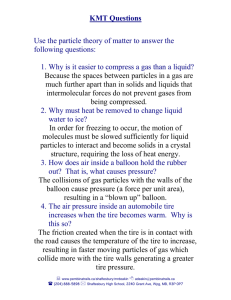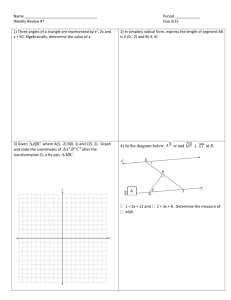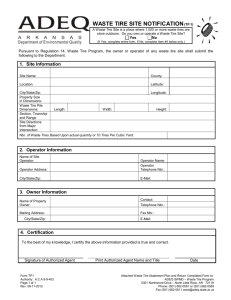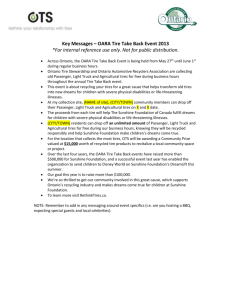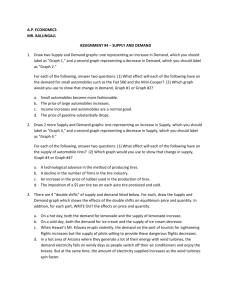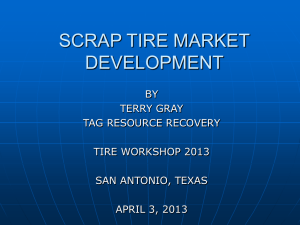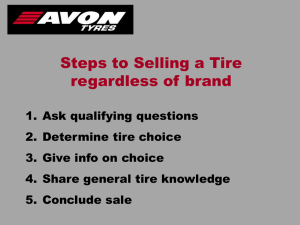MEGR3092 Tire Mechanics S2014 Syllabus and calendar rev B
advertisement
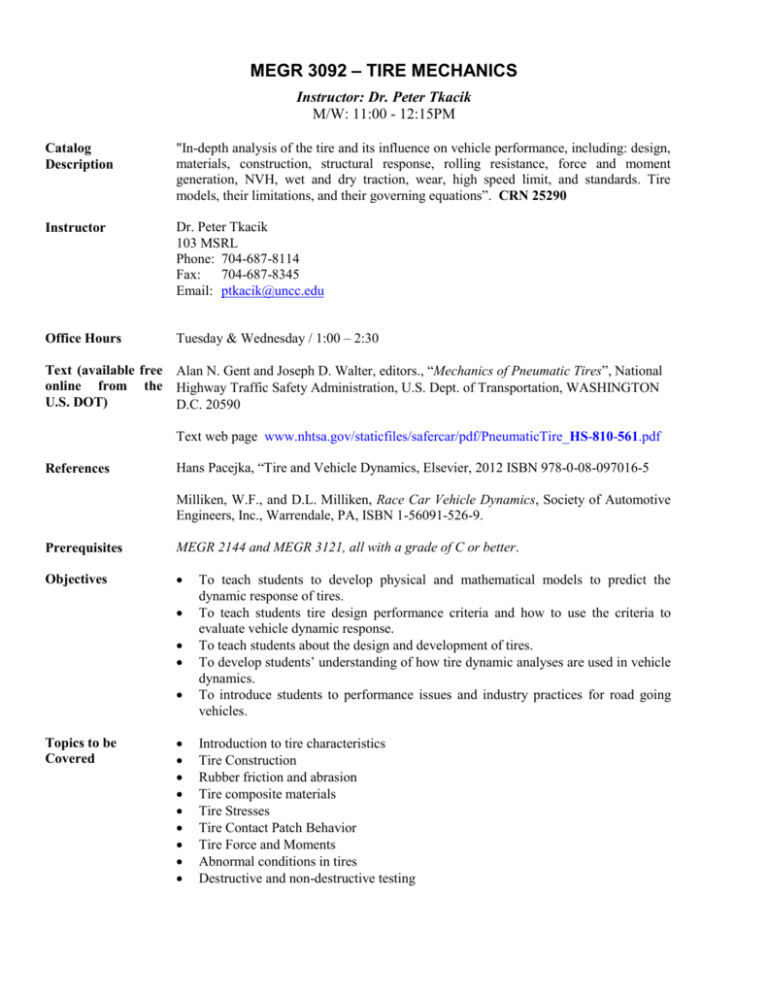
MEGR 3092 – TIRE MECHANICS Instructor: Dr. Peter Tkacik M/W: 11:00 - 12:15PM Catalog Description "In-depth analysis of the tire and its influence on vehicle performance, including: design, materials, construction, structural response, rolling resistance, force and moment generation, NVH, wet and dry traction, wear, high speed limit, and standards. Tire models, their limitations, and their governing equations”. CRN 25290 Instructor Dr. Peter Tkacik 103 MSRL Phone: 704-687-8114 Fax: 704-687-8345 Email: ptkacik@uncc.edu Office Hours Tuesday & Wednesday / 1:00 – 2:30 Text (available free Alan N. Gent and Joseph D. Walter, editors., “Mechanics of Pneumatic Tires”, National online from the Highway Traffic Safety Administration, U.S. Dept. of Transportation, WASHINGTON U.S. DOT) D.C. 20590 Text web page www.nhtsa.gov/staticfiles/safercar/pdf/PneumaticTire_HS-810-561.pdf References Hans Pacejka, “Tire and Vehicle Dynamics, Elsevier, 2012 ISBN 978-0-08-097016-5 Milliken, W.F., and D.L. Milliken, Race Car Vehicle Dynamics, Society of Automotive Engineers, Inc., Warrendale, PA, ISBN 1-56091-526-9. Prerequisites MEGR 2144 and MEGR 3121, all with a grade of C or better. Objectives Topics to be Covered To teach students to develop physical and mathematical models to predict the dynamic response of tires. To teach students tire design performance criteria and how to use the criteria to evaluate vehicle dynamic response. To teach students about the design and development of tires. To develop students’ understanding of how tire dynamic analyses are used in vehicle dynamics. To introduce students to performance issues and industry practices for road going vehicles. Introduction to tire characteristics Tire Construction Rubber friction and abrasion Tire composite materials Tire Stresses Tire Contact Patch Behavior Tire Force and Moments Abnormal conditions in tires Destructive and non-destructive testing MEGR 3092/7092 – Tire Mechanics Grading Student Learning Outcomes Homework Exams Exam 1 Exam 2 Final Total Spring 2014 20% 22% 22% 36% 100% Students will demonstrate that they can apply Newton’s three laws to analyze vehicle systems. Students will demonstrate an understanding of how to model tire performance. Students will demonstrate an understanding of how to model suspension components. Students will demonstrate an understanding of loading effects on tire performance. Students will demonstrate how to modify a vehicle to meet performance criteria. Other Policies: Homework Any homework assigned is intended to give the student practice and to ensure that he/she does not fall behind in work. Homework in this course is required to be an individual effort. Collaborative efforts on homework are not permitted unless specified by the instructor. Periodically, announced quizzes may be given on the assigned problems or other topics and graded for accuracy. If you are having difficulty with an assignment, please contact me by email for help or visit during office hours. Tests There will be two exams during the semester and a Final Exam at the end of the course. The use of computers, cell phones, iPads, etc. is prohibited during the tests. Only a “stand alone” calculator that cannot communicate with any other device is permitted. In the event that a test is missed without previous arrangement with the instructor, a grade of “zero” will be assigned and NO makeup test will be offered. This policy will not be waived except under extenuating circumstances and at the discretion of the instructor. Final Exam The final exam will be comprehensive. Computer Usage in Class Students are permitted to use computers during class for note-taking and other class-related work ONLY. Those using computers during class for work not related to that class, such as internet surfing, playing games or doing home-work for other courses, MUST leave the classroom for the remainder of the class period. 2 MEGR 3092/7092 – Tire Mechanics Spring 2014 Disclaimer Assignment sheets and course content are subject to modification when circumstances or sound pedagogy dictate and as the course progresses. If changes are made, you will be given due notice. Accommodations Students in this course seeking accommodations to disabilities must first consult with the Office of Disability Services and follow the instructions of that office for obtaining accommodations. Academic Integrity Policy Students have the responsibility to know and observe the requirements of the UNC Charlotte Code of Student Academic Integrity (1999-2001 Catalog, pages 375). This code forbids cheating, fabrication of falsification of information, multiple submission of academic work, plagiarism, abuse of academic materials, and complicity in academic dishonesty. Any special requirements or permission regarding academic integrity in this course will be stated by the instructor, and are binding on the students. Academic evaluations in this course include a judgment that the student's work is free from academic dishonesty of any type; and grades in this course therefore should be and will be adversely affected by academic dishonesty. Students who violate the code can be expelled from UNC Charlotte. The normal penalty for a first offense is zero credit on the work involving dishonesty and further substantial reduction of the course grade. In almost all cases the course grade is reduced to F. Copies of the code can be obtained from the Dean of Students Office. Standards of academic integrity will be enforced in this course. Students are expected to report cases of academic dishonestly to the course instructor. 3 MEGR 3092/7092 – Tire Mechanics Spring 2014 Class Number Date Class Topic* Chapter reading* 1 1/8/2014 Introduction, Tire basics Chapter 1 / 1-3.4 2 1/13/2014 Tire Testing Chapter 1 / 4 3 1/15/2014 Tire Manufacturing Chapter 1 / 5 4 1/20/2014 Tire Care Chapter 1 / 6 5 1/22/2014 Mechanical Properties of Rubber Chapter 2 / 1-2 6 1/27/2014 Rubber Friction Chapter 2 / 3 7 1/29/2014 Rubber Abrasion and Aging Chapter 2 / 4-5 8 2/3/2014 Tire Cord to Rubber bonding Chapter 3 9 2/5/2014 Mechanics of Cord-Rubber Composite Materials Chapter 4 10 2/10/2014 Tire Load Capacity Chapter 5 11 2/12/2014 Tire Stress Analysis Chapter 6 12 2/17/2014 Exam #1 13 2/19/2014 Contact Patch Phenomena (Footprint) Chapter 7 / 1-2 14 2/24/2014 Contact Patch Phenomena (Equipment) Chapter 7 / 3 15 2/26/2014 Contact Patch Phenomena (Physics) Chapter 7 / 4 - 3/3/2014 No Class, Spring Recess - 3/5/2014 No Class, Spring Recess 16 3/10/2014 Forces and Moments Chapter 8 / 1-3 17 3/12/2014 F&M (measurement) Chapter 8 / 4 18 3/17/2014 F&M (characteristics) Chapter 8 / 5-6 19 3/19/2014 F&M (modeling) Chapter 8 / 7 20 3/24/2014 F&M (modeling) Chapter 8 / 7 21 3/26/2014 Tire Noise and Vibration Chapter 9 22 3/31/2014 Waves in Rotating Tires Chapter 10 23 4/2/2014 Rubber Friction and Tire Traction Chapter 11 24 4/7/2014 Exam #2 25 4/9/2014 Rolling Resistance Chapter 12 26 4/14/2014 Rubber Abrasion and Tire Wear Chapter 13 27 4/16/2014 Vehicle Steady-State Handling Behavior Chapter 14 28 4/21/2014 Non-Destructive Tests and Inspections Chapter 16 29 4/23/2014 Tire Standards and Specifications Chapter 17 30 4/28/2014 Review for Final Exam 31 TBD Final Exam (cumulative) * subject to change at instructors discretion 4
